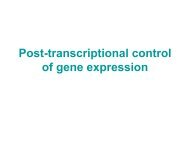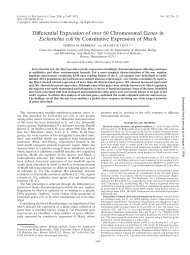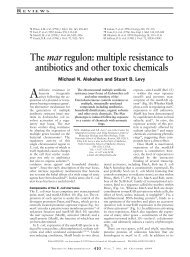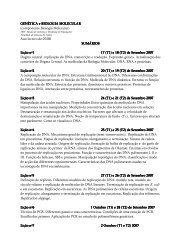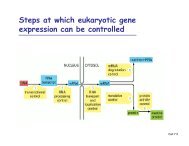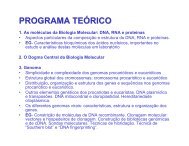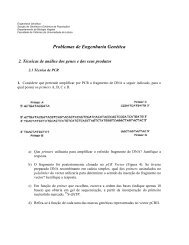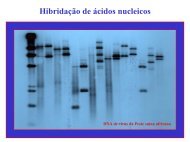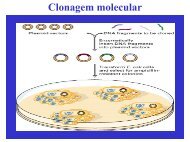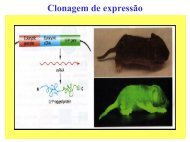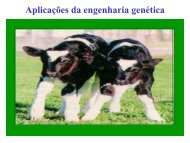Replicative transposition
Replicative transposition
Replicative transposition
Create successful ePaper yourself
Turn your PDF publications into a flip-book with our unique Google optimized e-Paper software.
Nature of transposable elements<br />
DNA móvel<br />
Elementos transponíveis
Hartl<br />
Direct and inverted repeats
Pierce<br />
Common characteristics of transposable<br />
elements
IR belongs to the transposable element
Mechanisms of<br />
<strong>transposition</strong><br />
<strong>Replicative</strong> <strong>transposition</strong><br />
(copy-paste)<br />
Conservative <strong>transposition</strong><br />
(cut-paste)
<strong>Replicative</strong> and Conservative <strong>transposition</strong>
Flanking direct repeats are generated when a<br />
transposable element inserts into DNA<br />
Conservative <strong>transposition</strong><br />
Pierce<br />
Ex. Tn10
<strong>Replicative</strong> <strong>transposition</strong><br />
A transposase makes a single-<br />
Strand breaks at each end of<br />
the transposable element<br />
Replication takes place on the<br />
single-stranded templates, begining<br />
at the 3’-OH ends of single strands<br />
Pierce<br />
The free ends of the transposable<br />
Element attach to the free ends<br />
of the target sequence
Replication proceeds through<br />
the transposable element and<br />
the target sequences<br />
Cointegrate resolution<br />
crossing over between sites<br />
within the transposable element<br />
Cointegrate formation with<br />
two copies of the transposable<br />
element and two copies of the<br />
target sequence<br />
Two separate copies of<br />
the transposable element.<br />
The new copy is flanked<br />
by direct repeats of the<br />
target sequence.<br />
Pierce
<strong>Replicative</strong> <strong>transposition</strong> requires singlestrand<br />
breaks, replication and resolution<br />
Tn3 has na internal resolution site
Consequences of <strong>transposition</strong><br />
and of recombination between<br />
transposable elements
Recombination between transposable elements (or<br />
other repeated sequences) in the same chromosome<br />
Two copies of tansposable elements can act in concert to transpose the<br />
DNA segments in between them
Consequências da transposição<br />
(exemplo)
Arrangement of flagellin genes on the<br />
Salmonella chromosome<br />
The promoter (P) is within a transposon. In one direction (a), the H2 operon is<br />
transcribed, which results in H2 flagellin and rH1 protein, the repressor of the<br />
H1 gene. In the the second orientation (b), the H2 operon is not transcribed,<br />
resulting in uninhibited transcription of the H1 gene
Pierce<br />
Chromosome rearrangements are often generated by<br />
<strong>transposition</strong>
Pierce<br />
inversion
Pierce
Brock<br />
Transposon mutagenesis
Consequências da transposição<br />
• Causa deleções e inversões<br />
• Melhoram fitness da bacteria<br />
• Mutagénese (interrompe expressão génica)<br />
• Aquisição de novos genes pelas células (dissiminação<br />
de resistência a antibióticos)<br />
• Evolução do genoma<br />
• Rearranjos na expressão génica<br />
• Podem servir de substracto para recombinação<br />
homóloga, que conduz a translocações e inversões
Regulação da transposição<br />
• Ao nível da transcrição da transposase<br />
• Ao nível da tradução do mRNA da<br />
transposase<br />
• Inibição do mecanismo de transposição<br />
– Ex RIP (repeat-induced point mutation)-<br />
mecanismo de defesa em que as sequências<br />
repetitivas sofrem mutações
Hartl 10.4<br />
Repressor of <strong>transposition</strong> in transposable elements in bacteria
Structure of transposable elements<br />
Transposable elements in bacteria<br />
Transposable elements in<br />
eukaryotes
Typical Insertion Sequence (IS)<br />
Insertion sequences are simple transposable elements found in bacteria<br />
Pierce
Pierce<br />
Stuctures of common insertion sequences
Tn10 ia a composite transposon in bacteria<br />
A composite transposon has a central region carrying markers (such as drug<br />
resistance) flanked by IS modules. The modules have short inverted terminal<br />
repeats. The modules themselves might be in inverted orientation (as drawn)<br />
or have the same orientation.
Two different transposons having different IR regions and carrying different<br />
drug-resistance genes.<br />
a) Tn9 has a short IR region, because the two IS1 elements<br />
are in the same orientation and each element has a short inverted repeat<br />
b) Tn10 has a large IR region because the two IS10 components have<br />
opposite directions and the entire IS10 sequence constitutes the inverted repeat<br />
Suzuki 20-15
Pierce
Transposon Left end Markers Right end<br />
Tn903 IS903 kan R both IS ends functional<br />
Tn10 IS10L tet R IS10R fuctional<br />
nonfunctional<br />
Tn5 IS50L kan R IS50R functional<br />
nonfunctional<br />
Tn9 IS1 cam R IS modules identical<br />
both functional
Suzuki 20-17<br />
Role of transposable elements in the evolution of<br />
antibiotic resistance plasmids carrying many<br />
resistance genes
Other transposable elements in bacteria<br />
Transposable phage<br />
Noncomposite transposon<br />
lack insertion sequences
Mu is a transposing bacteriophage<br />
Integration<br />
Replication<br />
Lysis<br />
etc<br />
. Does not posses IR<br />
. Inserts randomly into DNA<br />
. <strong>Replicative</strong> <strong>transposition</strong><br />
Pierce
Transposable elements in<br />
eukaryotes<br />
DNA transposable elements<br />
Retrotransposons
P element structure<br />
DNA transposable element of Drosophila<br />
. 2907 bp long<br />
. There is a perfect 31 bp IR at each terminus<br />
. Transposition is controlled by repressors encoded by the element<br />
Suzuki 20-37
Hybrid dygenesis in Drosophila is caused by the<br />
<strong>transposition</strong> of P elements<br />
Hybrid dygenesis is the<br />
sudden appearance of<br />
numerous mutations,<br />
chromosome aberrations<br />
and sterility in the offspring<br />
of a cross between:<br />
P + male fly x P - female fly.<br />
The reciprocal cross produces<br />
normal offspring.<br />
Pierce
Pierce
Some transposable elements can be used as tools for<br />
cloning and gene manipulation<br />
Two component<br />
transformation system<br />
Recognition sequences needed for <strong>transposition</strong><br />
- The wings-clipped P<br />
element is a modified<br />
P element that codes<br />
for a transposase but<br />
cannot transpose itself<br />
because critical recognition<br />
sequences are deleted<br />
- Random location<br />
- Transformats are detected<br />
among the progeny of the<br />
injected flies because of<br />
the eye color or other<br />
genetic marker included<br />
in the P vector
Retrotransposons<br />
Retroviral-like retrotransposons<br />
Nonretroviral retrotransposons
Suzuki 20.29<br />
Life cycle of a retrovirus
Retro<strong>transposition</strong><br />
Eukaryotic transposable elements that transpose through RNA intermediates are<br />
called retrotransposons
Retrotransposons transpose through RNA<br />
intermediates<br />
Retrotransposons do not<br />
encode transposase<br />
Retrotransposons also generate<br />
flanking direct repeats at their<br />
points of insertion in DNA<br />
Pierce
Retrotransposons<br />
(ex.)<br />
• Retroviral retrotransposons have properties similar to<br />
those of retrovirus<br />
– Ty elements in yeast<br />
– Drosophila copia elements<br />
Schematic representation of a viral transposon
Comparision of the genes of integrated retrovirus DNA and the<br />
yeast Ty element and Drosophila copia elements<br />
gag- capsid core proteins<br />
pol- reverse transcriptase<br />
int- integrase and protease<br />
env- envelope antigens<br />
The four functions encoded by the retroviral DNA have counterparts in the yeast and<br />
Drosophila elements<br />
Suzuki 20-35
Copia is a retrotransposable element of<br />
Drosophila<br />
After <strong>transposition</strong><br />
IR<br />
Seven families<br />
5 kb to 8.5 kb<br />
10-100 positions in Drosophila<br />
Pierce
Ty is a transposable element of yeast<br />
After <strong>transposition</strong><br />
Ex: Ty1 sequence appears approximately 35 times in the yeast genome<br />
Pierce
Demonstration of <strong>transposition</strong> through an RNA intermediate<br />
Galactose induced promoter<br />
Increased expression of Ty element<br />
Suzuki 20-33
Retrovirus and retroviral vs nonretroviral<br />
retrotransposons<br />
Encodes reverse transcriptase and moves<br />
via a RNA intermediate produced by<br />
promoter in LTR<br />
Ex in humans- THE-1<br />
Encodes reverse transcriptase and moves<br />
via a RNA intermediate produced from a<br />
neighboring promoter<br />
(more frequent in mammals)<br />
LINE- long interspersed nuclear element<br />
SINE- short interspersed nuclear element ex: Alu
Repetitive elements found in the human gene HGO<br />
(homogentisate 1,2-dioxygenase)<br />
Suzuki 20-36<br />
Alu- blue; SINEs- purple; LINEs- orange; LTRs (retrotransposons derived sequences)- red;<br />
SSRs (short-sequence repeats)- maroon
A proporção e o tipo de sequências repetitivas presentes no genoma dos eucariotas difere muito



